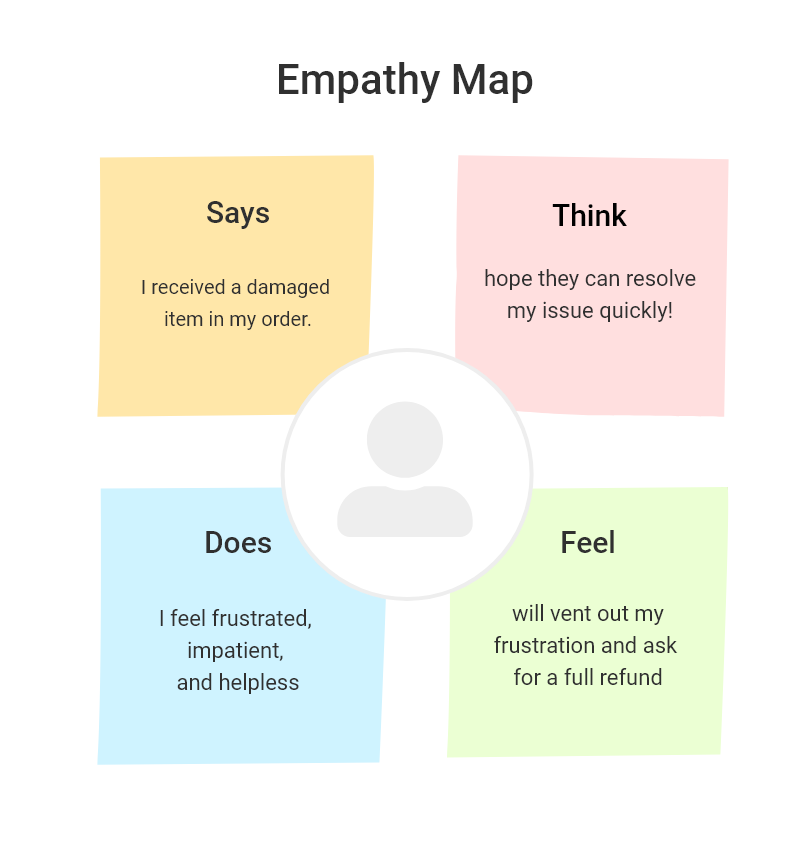At the heart of exceptional customer service lies a timeless quality — empathy.
Understanding and sharing your customers’ emotions can transform routine transactions into meaningful relationships. But how do you imbibe empathy in your team?
Empathy exercises for customer service can be a valuable way to enhance team members’ ability to understand and connect with others, whether they are customers, colleagues, or stakeholders.
In this blog, we delve into a series of empathy exercises designed to hone the skills of your customer service team, fostering a culture of understanding, compassion, and, ultimately, customer satisfaction.
Let’s go!
What Is an Empathy Exercise?
An empathy exercise is a structured activity or practice designed to enhance one’s ability to understand and share the feelings of another person. These exercises foster empathy, compassion, and a deeper understanding of different perspectives, ultimately improving interpersonal relationships and communication skills.
For example, a simple empathy exercise could involve participants pairing up and taking turns sharing personal experiences or challenges. The listener’s task is to actively listen without judgment, offering supportive responses to create a connection and understanding of the speaker’s emotions and perspective.
Read More: 30+ Empathy Statements for Customer Service
10 Empathy Exercises to Help Your Customer Service Team
No one made more sense about empathy than Meryl Streep when she said:
“The great gift of human beings is that we have the power of empathy; we can all sense a mysterious connection to each other.”
There is no doubt that empathy is one skill that every customer service professional should work on. If you don’t know where to start, here are 10 empathy exercises you can try.
1. Empathy Map

According to researchers at the University of Iowa, human beings retain what they see better than they hear. Why not use this research to your team’s advantage?
Empathy mapping is a visual tool that helps teams understand customer emotions and experiences. You can start this exercise by dividing an empathy map into four quadrants – “Says,” “Thinks,” “Feels,” and “Does.”
- Says: What the customer says, including their quotes, phrases, or expressions.
- Thinks: The internal thoughts, concerns, or considerations they might have.
- Feels: The customer’s emotional state, including their fears, hopes, and frustrations.
- Does: The observable actions or behaviors of the customer.
Once the map is ready, you can ask agents to fill these sections based on customer feedback, interactions, or social media comments. They can use sticky notes for this purpose.
For example, the Says quadrant can include, “I received a damaged item in my order.” Similarly, the Think quadrant can include, “I hope they can resolve my issue quickly.” Discussion on these maps aids in identifying areas for improvement and enhancing empathetic responses.
2. The Cause & Effect
Image Source: Giphy.com
Do humans have free will?
This small question has baffled philosophers for centuries. While we may not have a scientific consensus yet, it’s important to note that hundreds of factors dictate our emotions and decisions. In short, there are multiple causes that lead to our actions (effect).
In this exercise, ask your support reps to wear the detective’s hat and identify the causes behind different situations.
For example, “Why do you think the customer was angry on call?”
Now, ask each team member to share a unique answer. While one may say the customer was angry because he missed gifting the product to a loved one on their b’day, someone else may say the customer was angry as he probably had a rough day at work.
This simple empathy exercise can make your team see day-to-day situations from a bird’s eye perspective. Instead of judging people and their emotions, they will better understand the real causes.
3. Role-Playing Difficult Scenarios
You must have heard the an adage, “Fake it till you make it.” This is exactly what role-playing is all about.
Role-playing in customer service is a valuable training and empathy development tool. The idea is to make new support reps or interns simulate and practice handling challenging customer interactions in a controlled environment.
For this exercise, you can divide your team into pairs, where one plays the role of a customer and the other acts as a support rep.
Scenario: A customer has received a damaged product and is calling customer service for assistance. Encourage the one playing the customer to act as frustrated as they want and the support rep to show empathy, active listening, and problem-solving skills.
Following this exercise, conduct constructive feedback sessions to encourage learning and adaptation and prepare your team for real-world scenarios.
4. Gratitude Journaling
There are two kinds of people in this world – ones who see the glass as half full and the rest who see it as half empty.
As a customer service manager, you would want more people in your team who can see the bright side of things. This is where gratitude journaling can help your team practice and imbibe this skill.
Encourage team members to maintain a daily gratitude journal where they can write things, people, or experiences they are grateful for. For example, the journal can include:
“Dealt with a patient and understanding customer today. Grateful for customers who recognize and appreciate our efforts to assist them.“
Maintaining a daily gratitude journal fosters a positive mindset among team members. Also, sharing positive experiences during team meetings can help you foster a culture of appreciation. This exercise not only uplifts team morale but also encourages a more empathetic approach in customer interactions.
5. Empathy-Building Workshops
If you really wish to build empathy in your customer service team, why not seek help from industry experts?
Inviting experts to conduct workshops on empathy provides team members with theoretical knowledge and practical skills. This is what an ideal workshop schedule can look like:
- An expert introduces team members to the topic of empathy and its role in customer delight.
- Presents real or fictional case studies that highlight situations where empathy played a crucial role.
- Participants share personal stories that highlight moments of empathy
- Expert conducts an interactive Q&A session to answer all doubts and suggest tips
- Summarizes key takeaways from the workshop
Remember to create a safe and inclusive environment throughout the workshop, allowing participants to feel comfortable sharing and learning from one another.
Read More: Top 20 Customer Service Skills (With Examples & Tips)
6. Storytelling Sessions
As kids, we all loved hearing bedtime stories. But, guess what? Grown-ups equally enjoy a good story. No wonder Netflix is a billion-dollar company!
Storytelling sessions can make for a fun empathy exercise for your team.
Encourage your service reps to share real-life customer stories during team meetings. If you run out of personal stories, you can find exceptional cases of customer service by other brands and share them to motivate your team.
This is what a personal story can look like:
Story: “The Handwritten Note”
“Last year, I received a complaint from a customer, Sarah. She had experienced a shipping delay, and the product she ordered arrived damaged. Understandably, she was upset and frustrated.
I picked up the call and listened attentively, acknowledged her feelings, and genuinely apologized for the inconvenience. I not only processed a replacement order for Sarah but also shared a handwritten note expressing sincere apologies and a personalized recommendation for her favorite product.
Sarah was not only pleased with the quick resolution but genuinely touched by the personal touch of the handwritten note.”
End the storytelling session by emphasizing the impact of empathy in creating positive and memorable interactions with customers. Remind your team that every interaction is an opportunity to build long-term relationships and leave a lasting impression.
7. Complete-Me
This is probably the easiest of exercises shared in this blog.
All you have to do is sit with your team in a circle and let each member pick one chit from a bowl. Every chit should have an incomplete sentence, which the reader will have to complete once their turn comes.
Here are a few examples of incomplete sentences you can include:
- “I practice empathy by…”
- “I felt truly understood by a colleague when…”
- “One small act of kindness I witnessed recently was when…”
- “I show up to work every day because…”
- “I experienced the ripple effect of empathy when…”
The service representative picking the chit doesn’t have to complete the sentence immediately. Allow them a few seconds or minutes to ponder and then share their thoughts.
8. Turn on the Camera
When you are emailing or texting customers, things can be misinterpreted quite quickly. Imagine you make a small joke, and the customer takes it personally.
The best way to avoid this is through a virtual, face-to-face interaction. Observing the facial expressions and body language of the other person is instrumental in facilitating active listening and cultivating empathy.
For this exercise, involve every customer service rep, whether they handle customers via live chat, email, or the phone. Make it mandatory for them to connect with at least one customer over video call every week.
This need not be an hour-long interaction. Just encourage your team members to focus on facial expressions, hand gestures, and other body language cues. By turning on the camera, your team can pave the way for more meaningful and empathetic interactions.
9. Feedback Analysis
Customer feedback is an invaluable tool for customer service teams, serving as a compass for improvement, innovation, and customer satisfaction.
Instead of running away from feedback, why not embrace it, together as one team?
You can conduct a feedback analysis exercise during your stand-up meetings. Simply share anonymized customer feedback or complaints with the team. Facilitate a discussion on how team members would respond, keeping empathy at the forefront.
Analyzing real feedback helps the team understand the impact of their responses on customers and promotes empathy-driven improvements.
10. Give Reps an Empathy Score ⭐
In the customer service industry, performance metrics usually measure the responsiveness and speed of a representative. For instance, the average ticket response time is used to measure how quickly an agent responds to customer queries or complaints.
But what about empathy? How do you measure it in your team?
When you share a survey with customers after their problem is resolved, you can include another question, “On a scale of 1 to 10, how would you rate the agent’s ability to understand your concerns and needs during the interaction?“
This rating will help you measure empathy at both an individual and team level.
Remember, instead of treating this as a one-time exercise, make it an inclusive part of how your team’s performance is measured, tracked, and rewarded.
Read More: 15 Help Desk Metrics to Improve Customer Support
Go Beyond Scripted Responses With Empathy Exercises!
Customer service empathy exercises shared above can provide excellent avenues for fostering the development of empathy skills within your team. However, conducting one exercise once in a blue moon isn’t enough. Similar to a customer-centric culture, effective empathy skills should become a part of your team’s daily operations.
If you are in a managerial role, consider undertaking some of these exercises yourself initially. By experiencing them firsthand, you can share your own insights when introducing these practices to your team.
Once you have mastered empathy in customer service, the next big challenge is responsiveness and automation. This is where ProProfs Help Desk can be a game-changer! This cloud-based ticketing system lets you have meaningful conversations with customers on their preferred channels, reply faster with canned responses, and get insightful feedback with the help of in-built CX surveys.
Learn More About Empathy Exercises
What is empathy training?
Empathy training is a structured program designed to enhance individuals’ ability to understand and share others’ emotions. It involves exercises, role-playing, and discussions to develop active listening, perspective-taking, and compassionate communication skills. This training cultivates a more empathetic mindset, crucial in professions requiring interpersonal understanding, such as customer service.
Why is empathy important in customer service?
Empathy is crucial in customer service as it fosters genuine connections. Understanding and acknowledging customers’ emotions creates positive experiences, enhancing satisfaction and loyalty. Empathetic interactions resolve issues more effectively, contributing to a positive brand image. Moreover, in a competitive market, empathy stands out as a key factor in building lasting customer relationships.
Who should participate in the empathy exercise?
Empathy exercises are beneficial for everyone involved in customer interactions, making them relevant for various team members, including customer service representatives, managers, and even those in product development or marketing.
How often should one conduct the empathy exercise?
There are some empathy exercises, like giving your customer service reps an empathy score, that can be conducted on a daily basis. On the other hand, other exercises, like storytelling, role-playing, feedback analysis, etc., can be conducted weekly. More expensive or time-consuming exercises like empathy workshops can be conducted once every few months.
How do we measure the effectiveness of the empathy exercise?
To measure knowledge retention and empathy training effectiveness, you can share quizzes and surveys with your team members. You can also gauge their performance overtime through customer feedback and ratings.
 Tips
Tips
We’d love to hear your tips & suggestions on this article!
FREE. All Features. FOREVER!
Try our Forever FREE account with all premium features!

 We'd love your feedback!
We'd love your feedback! Thanks for your feedback!
Thanks for your feedback!







